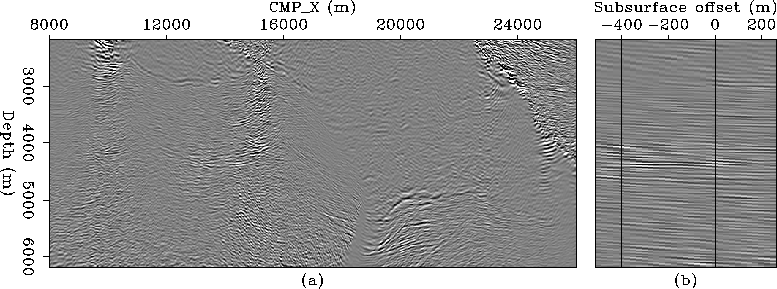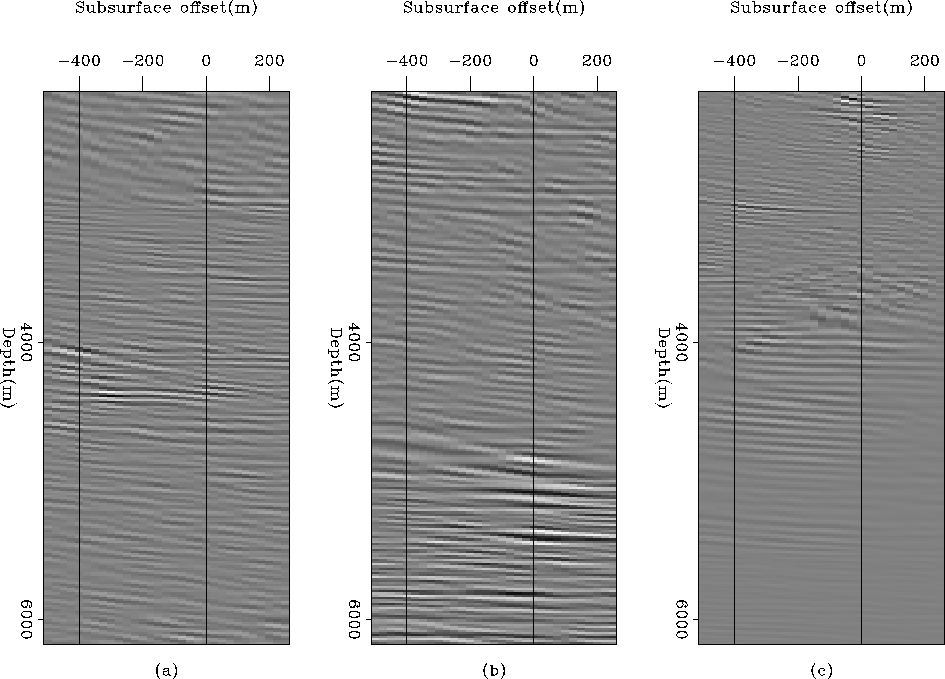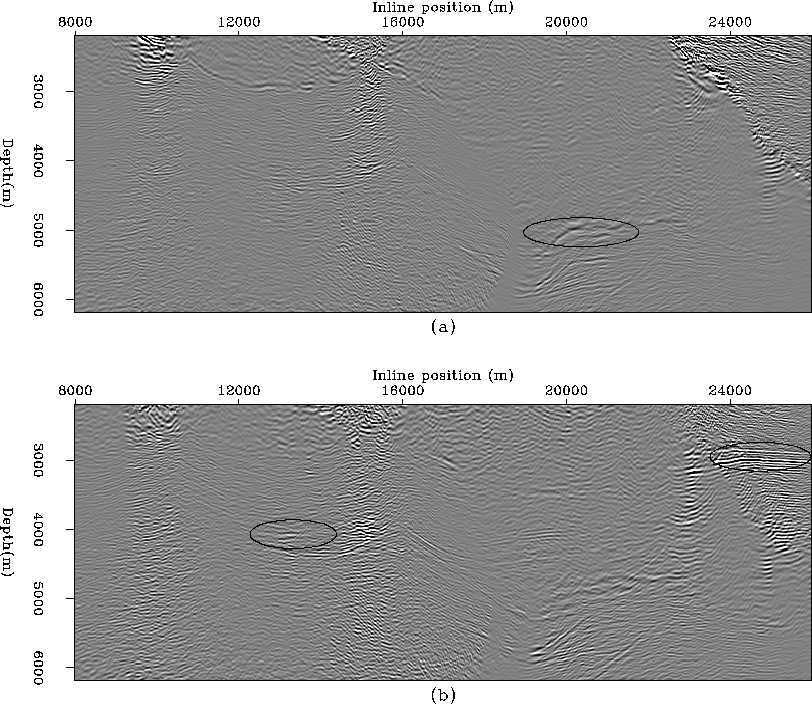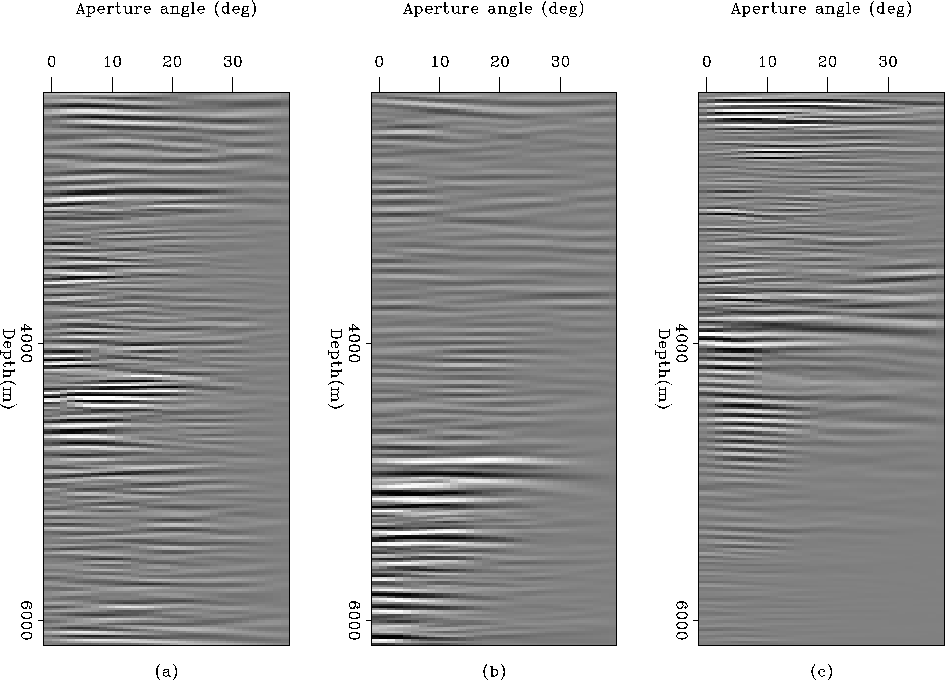




Next: Discussion
Up: Discrimination of multiples
Previous: Discrimination of multiples
Figure ![[*]](http://sepwww.stanford.edu/latex2html/cross_ref_motif.gif) shows the same inline section as in Figure
shows the same inline section as in Figure ![[*]](http://sepwww.stanford.edu/latex2html/cross_ref_motif.gif) but
this time taken from the migration of only one sail line. Notice that the salt boundaries are
poorly imaged because of the complexity of the salt geometry in the cross-line direction. Much
more data needs to be migrated from the cross-line direction in order to get these reflections
as can be seen by comparing with Figure
but
this time taken from the migration of only one sail line. Notice that the salt boundaries are
poorly imaged because of the complexity of the salt geometry in the cross-line direction. Much
more data needs to be migrated from the cross-line direction in order to get these reflections
as can be seen by comparing with Figure ![[*]](http://sepwww.stanford.edu/latex2html/cross_ref_motif.gif) . The right hand panel is now a subsurface
offset gather taken at the center of the window in Figure
. The right hand panel is now a subsurface
offset gather taken at the center of the window in Figure ![[*]](http://sepwww.stanford.edu/latex2html/cross_ref_motif.gif) (CMP position 13200 m).
Although not all
the multiples are imaged in this migration because of the lack of cross-line data as indicated
for the salt reflections, those imaged can be identified by their moveout away form zero
toward the negative subsurface offsets in the offset gather. Notice in particular the multiple
at about 4 km depth and -400 m subsurface offset.
2dmigoffs1
(CMP position 13200 m).
Although not all
the multiples are imaged in this migration because of the lack of cross-line data as indicated
for the salt reflections, those imaged can be identified by their moveout away form zero
toward the negative subsurface offsets in the offset gather. Notice in particular the multiple
at about 4 km depth and -400 m subsurface offset.
2dmigoffs1
Figure 10 Migration of one sail line. The left panel is an inline subsurface
offset common image gather.





Figure ![[*]](http://sepwww.stanford.edu/latex2html/cross_ref_motif.gif) shows three subsurface offset gathers taken at different lateral
positions. The first SODCIG (panel (a)), taken at about the center of the window in
Figure
shows three subsurface offset gathers taken at different lateral
positions. The first SODCIG (panel (a)), taken at about the center of the window in
Figure ![[*]](http://sepwww.stanford.edu/latex2html/cross_ref_motif.gif) (a) (CMP position 13200 m), shows evidence of multiples at
about 4000 m depth at -400 m half-subsurface offset. This multiple is difficult to identify in
Figure
(a) (CMP position 13200 m), shows evidence of multiples at
about 4000 m depth at -400 m half-subsurface offset. This multiple is difficult to identify in
Figure ![[*]](http://sepwww.stanford.edu/latex2html/cross_ref_motif.gif) because it essentially stacks out. It is, however visible in
the constant subsurface offset section of panel (b) in Figure
because it essentially stacks out. It is, however visible in
the constant subsurface offset section of panel (b) in Figure ![[*]](http://sepwww.stanford.edu/latex2html/cross_ref_motif.gif) (left oval).
The second SODCIG (panel (b)), taken below the big salt body
in Figure
(left oval).
The second SODCIG (panel (b)), taken below the big salt body
in Figure ![[*]](http://sepwww.stanford.edu/latex2html/cross_ref_motif.gif) (a) (CMP position 20800 m) shows no clear evidence of multiples
below the salt. The strong event below 20000 m and about 5000 m in Figure
(a) (CMP position 20800 m) shows no clear evidence of multiples
below the salt. The strong event below 20000 m and about 5000 m in Figure ![[*]](http://sepwww.stanford.edu/latex2html/cross_ref_motif.gif) is
actually the base of the salt and the events below it are subsalt primaries (see also the oval in panel
(a) of Figure
is
actually the base of the salt and the events below it are subsalt primaries (see also the oval in panel
(a) of Figure ![[*]](http://sepwww.stanford.edu/latex2html/cross_ref_motif.gif) ).
The last SODCIG,
(panel c), taken where the sediments meet the salt flank (CMP position 24900 m), show evidence of
multiples below 4000 m depth.
To further illustrate this point, Figure
).
The last SODCIG,
(panel c), taken where the sediments meet the salt flank (CMP position 24900 m), show evidence of
multiples below 4000 m depth.
To further illustrate this point, Figure ![[*]](http://sepwww.stanford.edu/latex2html/cross_ref_motif.gif) shows a comparison between the image
taken at zero subsurface offset, which should be mostly (but not exclusively) primaries, and
that obtained at -400 m half-subsurface offset, which should be mostly multiples. Notice in
particular the multiple above a depth of 3000 m to the right of the inline distance of 24000 m
as indicated by the right oval. Also notice the flattish event at about 4000 m depth and 13000 m
inline distance (left oval). This is likely to be a multiple obscuring the weak primaries.
shows a comparison between the image
taken at zero subsurface offset, which should be mostly (but not exclusively) primaries, and
that obtained at -400 m half-subsurface offset, which should be mostly multiples. Notice in
particular the multiple above a depth of 3000 m to the right of the inline distance of 24000 m
as indicated by the right oval. Also notice the flattish event at about 4000 m depth and 13000 m
inline distance (left oval). This is likely to be a multiple obscuring the weak primaries.
2dsodcigs1
Figure 11 Subsurface offset common image gathers taken at lateral positions
(a): 13200 m, (b): 20800 m and (c): 24930 m.




 2dcoffs1
2dcoffs1
Figure 12 Common subsurface offset sections taken at
(a): 0 and (b): -400 m half-subsurface offset.





Since I expect to attenuate the multiples in ADCIGs rather than SODCIGs, it is interesting to
see how the multiples in this 2D migration are mapping to ADCIGs. This is illustrated in
Figure ![[*]](http://sepwww.stanford.edu/latex2html/cross_ref_motif.gif) that shows ADCIGs for the same SODCIGs shown in
Figure
that shows ADCIGs for the same SODCIGs shown in
Figure ![[*]](http://sepwww.stanford.edu/latex2html/cross_ref_motif.gif) . Again, notice in panel (a) the down curvature of the multiple
at about 6000 m at zero aperture angle. There seems to be another multiple at above 7000 m
depth. In contrast, no clear evidence of multiple can be seen in the ADCIG in panel (b).
In panel (c) there is some evidence of multiples at a depth of about 6300 m depth but at the
same depth there seem to be primaries as well. The situation will probably be more clear once
the ADCIG is computed after migrating all the data.
. Again, notice in panel (a) the down curvature of the multiple
at about 6000 m at zero aperture angle. There seems to be another multiple at above 7000 m
depth. In contrast, no clear evidence of multiple can be seen in the ADCIG in panel (b).
In panel (c) there is some evidence of multiples at a depth of about 6300 m depth but at the
same depth there seem to be primaries as well. The situation will probably be more clear once
the ADCIG is computed after migrating all the data.
2dadcigs1
Figure 13 Angle domain common image gathers
corresponding to the subsurface offset domain common image gathers
in Figure ![[*]](http://sepwww.stanford.edu/latex2html/cross_ref_motif.gif)










Next: Discussion
Up: Discrimination of multiples
Previous: Discrimination of multiples
Stanford Exploration Project
5/6/2007

![[*]](http://sepwww.stanford.edu/latex2html/cross_ref_motif.gif) shows the same inline section as in Figure
shows the same inline section as in Figure ![[*]](http://sepwww.stanford.edu/latex2html/cross_ref_motif.gif) but
this time taken from the migration of only one sail line. Notice that the salt boundaries are
poorly imaged because of the complexity of the salt geometry in the cross-line direction. Much
more data needs to be migrated from the cross-line direction in order to get these reflections
as can be seen by comparing with Figure
but
this time taken from the migration of only one sail line. Notice that the salt boundaries are
poorly imaged because of the complexity of the salt geometry in the cross-line direction. Much
more data needs to be migrated from the cross-line direction in order to get these reflections
as can be seen by comparing with Figure ![[*]](http://sepwww.stanford.edu/latex2html/cross_ref_motif.gif) . The right hand panel is now a subsurface
offset gather taken at the center of the window in Figure
. The right hand panel is now a subsurface
offset gather taken at the center of the window in Figure ![[*]](http://sepwww.stanford.edu/latex2html/cross_ref_motif.gif) (CMP position 13200 m).
Although not all
the multiples are imaged in this migration because of the lack of cross-line data as indicated
for the salt reflections, those imaged can be identified by their moveout away form zero
toward the negative subsurface offsets in the offset gather. Notice in particular the multiple
at about 4 km depth and -400 m subsurface offset.
(CMP position 13200 m).
Although not all
the multiples are imaged in this migration because of the lack of cross-line data as indicated
for the salt reflections, those imaged can be identified by their moveout away form zero
toward the negative subsurface offsets in the offset gather. Notice in particular the multiple
at about 4 km depth and -400 m subsurface offset.

![[*]](http://sepwww.stanford.edu/latex2html/cross_ref_motif.gif) shows three subsurface offset gathers taken at different lateral
positions. The first SODCIG (panel (a)), taken at about the center of the window in
Figure
shows three subsurface offset gathers taken at different lateral
positions. The first SODCIG (panel (a)), taken at about the center of the window in
Figure ![[*]](http://sepwww.stanford.edu/latex2html/cross_ref_motif.gif) (a) (CMP position 13200 m), shows evidence of multiples at
about 4000 m depth at -400 m half-subsurface offset. This multiple is difficult to identify in
Figure
(a) (CMP position 13200 m), shows evidence of multiples at
about 4000 m depth at -400 m half-subsurface offset. This multiple is difficult to identify in
Figure ![[*]](http://sepwww.stanford.edu/latex2html/cross_ref_motif.gif) because it essentially stacks out. It is, however visible in
the constant subsurface offset section of panel (b) in Figure
because it essentially stacks out. It is, however visible in
the constant subsurface offset section of panel (b) in Figure ![[*]](http://sepwww.stanford.edu/latex2html/cross_ref_motif.gif) (left oval).
The second SODCIG (panel (b)), taken below the big salt body
in Figure
(left oval).
The second SODCIG (panel (b)), taken below the big salt body
in Figure ![[*]](http://sepwww.stanford.edu/latex2html/cross_ref_motif.gif) (a) (CMP position 20800 m) shows no clear evidence of multiples
below the salt. The strong event below 20000 m and about 5000 m in Figure
(a) (CMP position 20800 m) shows no clear evidence of multiples
below the salt. The strong event below 20000 m and about 5000 m in Figure ![[*]](http://sepwww.stanford.edu/latex2html/cross_ref_motif.gif) is
actually the base of the salt and the events below it are subsalt primaries (see also the oval in panel
(a) of Figure
is
actually the base of the salt and the events below it are subsalt primaries (see also the oval in panel
(a) of Figure ![[*]](http://sepwww.stanford.edu/latex2html/cross_ref_motif.gif) ).
The last SODCIG,
(panel c), taken where the sediments meet the salt flank (CMP position 24900 m), show evidence of
multiples below 4000 m depth.
To further illustrate this point, Figure
).
The last SODCIG,
(panel c), taken where the sediments meet the salt flank (CMP position 24900 m), show evidence of
multiples below 4000 m depth.
To further illustrate this point, Figure ![[*]](http://sepwww.stanford.edu/latex2html/cross_ref_motif.gif) shows a comparison between the image
taken at zero subsurface offset, which should be mostly (but not exclusively) primaries, and
that obtained at -400 m half-subsurface offset, which should be mostly multiples. Notice in
particular the multiple above a depth of 3000 m to the right of the inline distance of 24000 m
as indicated by the right oval. Also notice the flattish event at about 4000 m depth and 13000 m
inline distance (left oval). This is likely to be a multiple obscuring the weak primaries.
shows a comparison between the image
taken at zero subsurface offset, which should be mostly (but not exclusively) primaries, and
that obtained at -400 m half-subsurface offset, which should be mostly multiples. Notice in
particular the multiple above a depth of 3000 m to the right of the inline distance of 24000 m
as indicated by the right oval. Also notice the flattish event at about 4000 m depth and 13000 m
inline distance (left oval). This is likely to be a multiple obscuring the weak primaries.


![[*]](http://sepwww.stanford.edu/latex2html/cross_ref_motif.gif) that shows ADCIGs for the same SODCIGs shown in
Figure
that shows ADCIGs for the same SODCIGs shown in
Figure ![[*]](http://sepwww.stanford.edu/latex2html/cross_ref_motif.gif) . Again, notice in panel (a) the down curvature of the multiple
at about 6000 m at zero aperture angle. There seems to be another multiple at above 7000 m
depth. In contrast, no clear evidence of multiple can be seen in the ADCIG in panel (b).
In panel (c) there is some evidence of multiples at a depth of about 6300 m depth but at the
same depth there seem to be primaries as well. The situation will probably be more clear once
the ADCIG is computed after migrating all the data.
. Again, notice in panel (a) the down curvature of the multiple
at about 6000 m at zero aperture angle. There seems to be another multiple at above 7000 m
depth. In contrast, no clear evidence of multiple can be seen in the ADCIG in panel (b).
In panel (c) there is some evidence of multiples at a depth of about 6300 m depth but at the
same depth there seem to be primaries as well. The situation will probably be more clear once
the ADCIG is computed after migrating all the data.

![[*]](http://sepwww.stanford.edu/latex2html/cross_ref_motif.gif)